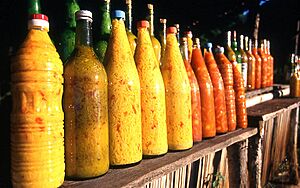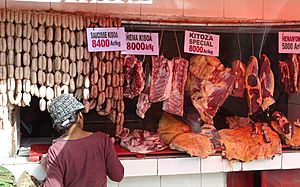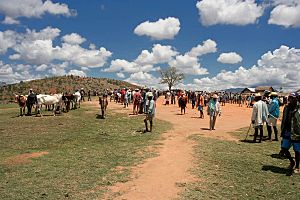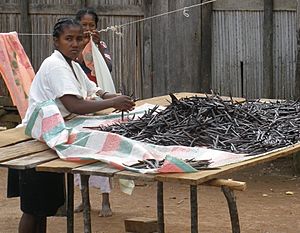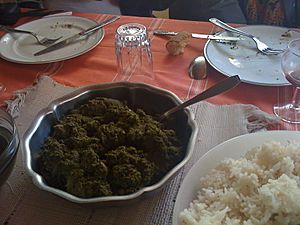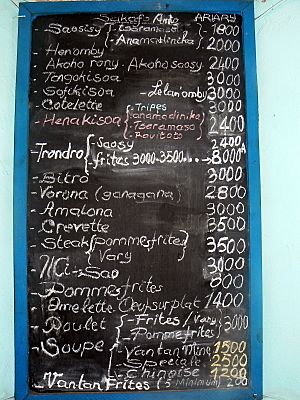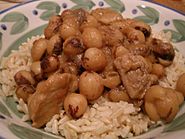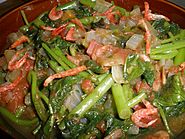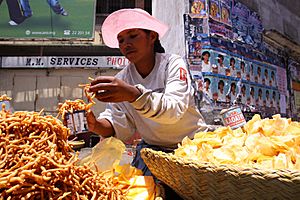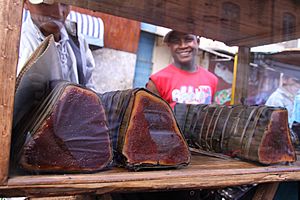Malagasy cuisine facts for kids
Malagasy cuisine is all about the many different food traditions found on the island of Madagascar. The foods people eat there show influences from Southeast Asia, Africa, India, China, and Europe. These influences came from people who settled on the island over many centuries. The first settlers arrived from Borneo between 100 CE and 500 CE.
Rice is the most important food in the Malagasy diet. The first settlers grew rice along with root vegetables and other foods from Southeast Asia. They also hunted wild animals, which sadly led to some large animals and birds disappearing from the island. Later, around 1,000 CE, people from East Africa brought zebu cattle to Madagascar, adding beef to the diet.
Trade with Arab and Indian merchants, and later European traders, brought even more new fruits, vegetables, and spices to the island.
Today, most meals in Madagascar include rice, called vary, served with a side dish called laoka. Laoka can be vegetarian or include meat or fish. It usually comes with a sauce flavored with ginger, onion, garlic, tomato, vanilla, salt, or curry powder. In some dry southern and western parts of the island, people who raise cattle might eat maize, cassava, or curds made from zebu milk instead of rice.
You can find many sweet and savory fried snacks, called fritters, and other street foods all over the island. There are also many different tropical and temperate fruits. Popular local drinks include fruit juices, coffee, herbal teas, and alcoholic drinks like rum, wine, and beer.
The foods eaten in Madagascar today show the island's long history and its many different cultures. Meals can be simple, like the traditional dishes of the first settlers. Or they can be fancy, like the special festival foods prepared for the island's 19th-century kings and queens.
Even though rice with laoka is still the main meal, other foods have become popular in the last 100 years. This is thanks to French colonists and immigrants from China and India. So, Malagasy food is both traditional and always taking in new ideas.
Contents
History of Malagasy Cuisine
Early Food Traditions (Before 1650)
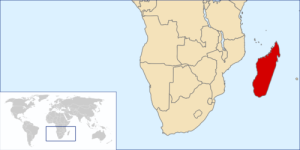
Experts believe that Austronesian sailors were the first people to settle in Madagascar. They arrived between 100 and 500 CE. They traveled in outrigger canoes and brought important foods from their homes. These included rice, plantains, taro, and water yam. They likely also brought sugarcane, ginger, sweet potatoes, pigs, and chickens, along with coconuts and bananas.
The first large groups of settlers lived along the southeastern coast. When they arrived, they used tavy, a "slash-and-burn" farming method. This meant they cleared parts of the coastal rainforests to grow crops. They also collected honey, fruits, bird and crocodile eggs, mushrooms, edible seeds, and roots. They even made alcoholic drinks from honey and sugar cane juice.
People regularly hunted and trapped animals in the forests. These included frogs, snakes, lizards, hedgehogs, tenrecs, tortoises, wild boars, insects, larvae, birds, and lemurs. The first settlers also found Madagascar's huge ancient animals, called megafauna. These included giant lemurs, elephant birds, giant fossa, and the Malagasy hippopotamus. Early Malagasy people might have eaten the eggs and sometimes the meat of Aepyornis maximus. This was the world's largest bird, and it lived in Madagascar until the 1600s.
Scientists have different ideas about why Madagascar's megafauna disappeared. But it seems clear that hunting by humans and destroying habitats through slash-and-burn farming were major reasons. Even though it's been illegal to hunt lemurs since 1964, these endangered animals are still hunted in some rural areas. This is either for food or to supply some city restaurants.
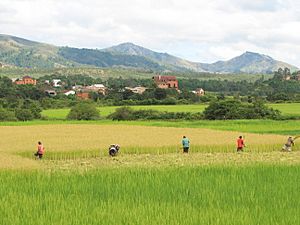
As more forests were lost to tavy, communities started planting crops on permanent plots of land. By 600 CE, some early settlers moved inland. They began clearing the forests in the central highlands.
At first, rice was grown dry or in wet lowland areas, but this didn't produce much food. Irrigated rice paddies were adopted in the highlands around 1600. This happened first in the Betsileo region, then later in the Imerina region. Over the next century, as terraced paddies spread, most of the original forest in central Madagascar was gone. In its place were villages surrounded by rice paddies and fields. Beyond these were large plains of grass.
Zebu cattle, which have a hump, were brought to the island around 1000 CE by settlers from East Africa. These settlers also brought sorghum, goats, and other foods. In East African and Malagasy cultures, zebu were a sign of wealth. So, they were rarely eaten, usually only at important spiritual events like funerals. Fresh zebu milk and curds were a big part of the diet for people who raised cattle.
Large herds of zebu were kept in the south and west. But some escaped and reproduced, creating a large wild zebu population in the highlands. Stories say that people in the highlands didn't know zebu were edible until King Ralambo's rule (1575–1612). He is often given credit for this discovery. However, old evidence suggests zebu were sometimes hunted in the highlands before his time. It's more likely that during Ralambo's rule, these wild herds were first tamed and kept in pens. This was also when more organized kingdoms started to appear in the highlands.
Foods were usually prepared by boiling them in water. Early people used green bamboo as pots, and later clay or iron pots. Foods were also roasted over a fire or grilled on hot stones or coals. Fermentation was used to make curds from milk. It also helped develop the flavor of some dried or fresh root vegetables. People also made alcoholic drinks from honey, sugarcane juice, or other local plants.
Methods like sun drying, smoking, and salting were used to preserve foods. This helped with transport, trade, or for eating later. Many foods prepared this way, like smoked dried beef called kitoza and salted dried fish, are still eaten in Madagascar today.
By the 1500s, powerful kingdoms had formed. These included the Sakalava on the west coast and the Merina in the Central Highlands. The Merina kings and queens celebrated the new year with an old ceremony called the Royal Bath (fandroana). For this event, a special beef dish called jaka was made. Beef was put in a clay jar, sealed with fat, and buried for a year. The jaka would then be shared with friends at the next year's festival. For dessert, people ate rice boiled in milk and drizzled with honey, called tatao.
Stories say King Ralambo started these food traditions in Imerina. His father, King Andriamanelo, is known for starting the marriage tradition of the vodiondry. This means "rump of the sheep." In this tradition, the groom would offer the best cut of meat—the hindquarters—to the bride-to-be's parents at their engagement ceremony. Today, the name vodiondry is still used, but families usually offer symbolic coins instead of food.
New Foods and Influences (1650–1800)
The Atlantic slave trade led to more ships trading at Malagasy ports, bringing new food products. In 1696, a trading ship going to the American colonies reportedly took local Malagasy rice to Charleston, South Carolina. This rice became the basis for the rice farming industry there. Trading ships also brought crops from the Americas to Madagascar in the 16th and 17th centuries. These included sweet potato, tomato, maize, peanuts, tobacco, and lima beans. Cassava arrived after 1735 from a French colony on nearby Réunion Island.
These new foods were first grown in coastal areas near the ports. But they quickly spread across the island. Within 100 years, they were common throughout the central highlands. Similarly, pineapple and citrus fruits like lemons, limes, and oranges were brought to Malagasy ports. Sailors ate these fruits to prevent scurvy on long ocean trips. Local people soon started growing them.
The prickly pear cactus, or raketa, was brought from the New World to the French settlement at Fort Dauphin in 1769. This plant spread throughout southern Madagascar. It became a very important food crop for the Mahafaly and Bara people who raised cattle. Eating about six of its fruits meant people didn't need to drink water. And after the spines were removed, the plant's pads fed and hydrated their zebu cattle. This plant helped southern cattle herders stay in one place more. It also made their herding more efficient, leading to more people and cattle in the region.
Royal Cuisine and Plantations (1800–1896)
The 1700s in the central highlands saw more people living there, which led to famines. These famines were made worse by wars among the different Merina groups.
At the start of the 1800s, King Andrianampoinimerina (1787–1810) successfully united these Merina groups. He used slaves and forced labor to work the irrigated rice fields around Antananarivo. This way, he made sure there was always enough rice to feed everyone. They even had extra to trade with other parts of the island. Markets were set up across the island to trade specific goods. These included smoked and dried seafood and meats, dried maize, salt, dried cassava, and various fruits. Rice cakes, like mofo gasy and menakely, were also sold by market vendors.
By this time, coastal food had also changed. Travelers in the early 1800s reported eating dishes on Île Sainte-Marie made with curry powder. These included a spiced rice dish similar to biryani. They also drank coffee and tea.
Andrianampoinimerina's son, Radama I, managed to unite almost the entire island under his rule. He established the Kingdom of Madagascar. Merina kings and queens continued to rule the island until the French took over in 1896.
Under the Kingdom of Madagascar, large farms called plantations were created. These grew crops to sell to other countries like England and France. Cloves were brought in and planted in 1803. Coconuts, which were not very common before, were grown on plantations to make oil. Coffee had been grown on small family plots. But in the early 1800s, more intensive farming for export began.
Vanilla, which later became one of Madagascar's most important export crops, was brought by French business people in 1840. It was planted in the eastern coastal rainforests. The method of hand pollination, which helps grow much more vanilla, was introduced 30 years later. Still, vanilla was not a major crop until the end of the monarchy.
During Merina royal festivals, seven special dishes called hanim-pito loha were eaten. These were considered the most delicious foods in the kingdom. They included voanjobory (Bambara groundnut), amalona (eel), vorivorinkena (beef tripe), Ravitoto (grated cassava leaves), and vorontsiloza (turkey). Each of these was cooked with pork, and usually with ginger, garlic, onion, and tomato. Romazava (a stew of beef and greens) and varanga (shredded roast beef) completed the list.
When France colonized Madagascar, the Malagasy monarchy and its grand feasts ended. But the traditions of this elegant cuisine were kept alive in homes. These dishes are still eaten regularly and served in many restaurants across the island.
Colonial Influences (1896–1960)
French colonial rule began in 1896 and brought many new things to local foods. Some new food names came from the French language, which was then the main language of the government. Baguettes became popular among city dwellers, as did various French pastries and desserts. These included cream horns, mille-feuille, croissants, and chocolat chaud (hot chocolate).
The French also introduced foie gras, which is now made locally. They also made popular a dish known in the highlands as composé. This is a cold macaroni salad mixed with blanched vegetables, similar to the French macédoine de légumes.
The French set up plantations to grow various crops for sale to other countries. These included crops already grown in the 1800s, plus new foreign fruits, vegetables, and livestock. Tea, coffee, vanilla, coconut oil, and spices became successful exports. Coconut became a regular ingredient in coastal cooking. Vanilla started to be used in sauces for chicken and seafood dishes.
A few Chinese settlers had arrived in Madagascar before the end of Queen Ranavalona III's rule. But the first large group of Chinese migrants came after General Joseph Gallieni, the first governor general of the colony, asked for 3,000 Chinese workers. They were needed to build a northern railway line between Antananarivo and Toamasina.
Chinese migrants brought many dishes that became popular urban foods in areas with large Chinese communities. These include riz cantonais (Chinese fried rice), soupe chinoise (Chinese-style noodle soup), misao (fried noodles), pao (hum bao), and nems (fried egg rolls).
By the 1880s, about 200 Indian traders had settled at Mahajanga. This was a port on the northwest coast of Madagascar. Thirty years later, the Indian population in Madagascar grew to over 4,000. They mainly lived in the trading ports along the northwestern coast.
These early Indian communities made curries and biryanis popular throughout the region. Khimo, a dish based on the Indian keema, became a specialty of Mahajanga. Indian samosas (sambos) soon became a popular street food in most parts of Madagascar. They are also known as tsaky telozoro, meaning "three-cornered snack."
While French influences added much to the cuisine, not every change was good. Since the French brought the prickly pear cactus in the 1700s, people in the south who raised cattle relied on the plant. It provided food and water for their zebu, and fruit and water for themselves during the dry season. However, in 1925, a French colonist wanted to get rid of the cactus on his land in Toliara. He introduced the cochineal, an insect that is a parasite of the plant. Within five years, almost all the prickly pear cactus in southern Madagascar was wiped out. This caused a huge famine from 1930–1931. Although these ethnic groups have since adapted, the famine is remembered as the time when their traditional way of life ended due to foreigners arriving on their land.
Malagasy Food Today
Since Madagascar became independent from French rule in 1960, its food has continued to show the island's many cultures and historical influences. Across the country, rice is considered the most important food. It is the main part of the diet everywhere except in the driest parts of the south and west. The side dishes served with rice change depending on what ingredients are available and local customs.
Outside of homes, Malagasy food is served at simple roadside stalls called gargottes or sit-down restaurants called hotely. Snacks and rice meals can also be bought from street vendors. Fancy restaurants offer a wider range of foreign foods and Malagasy dishes that show French and other outside influences in how they are made, what ingredients they use, and how they are presented.
Rice (Vary)
Rice (vary) is the main food in Madagascar and is usually eaten at every meal. The Malagasy word for "to eat a meal" is often mihinam-bary, which literally means "to eat rice." Rice can be cooked with different amounts of water. It can be a fluffy dry rice (vary maina) eaten with a side dish (laoka) in sauce. Or it can be a soupy rice porridge called vary sosoa. This porridge is usually eaten for breakfast or given to sick people. Vary sosoa might be served with a dry laoka like kitoza, which are smoked strips of zebu meat. A popular version, vary amin'anana, is a traditional porridge made with rice, meat, and chopped greens.
During a highland famadihana (reburial ceremony), a special rice called vary be menaka is eaten. This means "rice with much fat." It is rice served with fatty pieces of beef or, even better, very fatty pieces of pork.
Side Dishes (Laoka)
The side dish served with rice is called laoka in the official Malagasy language. Laoka dishes are most often served in some kind of sauce. In the highlands, this sauce is usually tomato-based. In coastal areas, coconut milk is often added during cooking. In the dry southern and western parts where raising zebu is common, fresh or curdled zebu milk is often used in vegetable dishes.
Laoka dishes are very diverse. They can include Bambara groundnuts with pork, beef, or fish. Other options are trondro gasy (various freshwater fish) or shredded cassava leaves with peanuts, beef, or pork. Henan'omby (beef) or akoho (chicken) might be stir-fried with ginger and garlic. Or they might be simmered in their own juices, a dish called ritra. Various types of seafood are more common along the coasts or in big cities.
Many local greens are used. These include anamamy (Morelle greens), anamafaitra (Martin greens), and especially anamalao (paracress). Anamalao is special because its boiled leaves and flowers create a mild numbing effect. Other common greens are anandrano (watercress) and anatsonga (bok choy).
In the dry south and west, among groups like the Bara or Tandroy people, main foods include sweet potato, yams, taro root, and especially cassava, millet, and maize. These are usually boiled in water and sometimes served with whole milk or flavored with crushed peanuts.
Garlic, onions, ginger, tomatoes, mild curry, and salt are the most common ingredients for flavoring dishes. In coastal areas, other ingredients like coconut milk, vanilla, cloves, or turmeric may also be used. A variety of condiments are served on the side. People mix them into their rice or laoka to their own taste, rather than adding them during cooking. The most common condiment, sakay, is a spicy sauce made from red or green chili pepper.
Indian-style condiments made of pickled mango, lemon, and other fruits (known as achards or lasary) are a coastal specialty. In the highlands, lasary often means a salad of green beans, cabbage, carrots, and onion in a vinaigrette sauce. This is popular as a side dish or as the filling for a baguette sandwich.
Ro (a broth) can be served as the main laoka or in addition to it, to flavor and moisten the rice. Ro-mangazafy is a rich and tasty broth made with beef, tomato, and garlic. It often goes with a dry laoka. In contrast, Romatsatso is a light broth made with onion, tomato, and anamamy greens, served with meat or fatty poultry. Ron-akoho, a broth made with chicken and ginger, is a home remedy for the common cold. Rompatsa is a broth made with tiny dried shrimp and beef, often with sweet potato leaves and potato added.
The national dish is a broth called Romazava. In its simplest form, it's made of beef with anamalao, anantsonga, or anamamy. But ingredients like tomato, onion, and ginger are often added for more flavor. Romazava is special because it includes anamalao flowers, which create a mild numbing feeling when eaten.
Street Foods
Many cakes and fried snacks, known as mofo (meaning "bread"), are sold at kiosks in towns and cities across Madagascar. The most common is mofo gasy, or "Malagasy bread." It's made from a sweet rice flour batter poured into round molds and cooked over charcoal.
Mofo gasy is a popular breakfast food, often eaten with coffee, which is also sold at kiosks. In coastal areas, this mofo is made with coconut milk and called mokary. Other sweet mofo include a deep-fried doughnut called menakely and a fried dough ball called mofo baolina. There are also various fruit fritters, with pineapple and bananas being the most common fruits used.
Savory mofo include ramanonaka, which is a salted mofo gasy fried in lard. Another is mofo sakay, meaning "spicy bread," a fritter flavored with chopped greens, onions, tomatoes, and chilies.
In markets and at gas stations, you might find vendors selling koba akondro. This is a sweet treat made by wrapping a batter of ground peanuts, mashed bananas, honey, and corn flour in banana leaves. The small cakes are then steamed or boiled until the batter sets.
Peanut brittle, dried bananas, balls of tamarind paste rolled in colored sugar, and deep-fried wonton-like dough strings called kaka pizon are all commonly sold on the street. Kaka pizon is also eaten in nearby Reunion Island. Homemade yogurts are also common. In rural areas, steamed cassava or sweet potatoes are eaten, sometimes with fresh or sweetened condensed milk.
Desserts
Traditionally, fresh fruit is eaten after a meal as a dessert. Fresh sugarcane can also be chewed as a treat. Many different temperate and tropical fruits grow locally. They can be enjoyed fresh or sprinkled with sugar.
Temperate fruits found in Madagascar include apples, lemons, pumpkins, watermelon, oranges, cherries, and strawberries.
Among the many tropical fruits commonly eaten in Madagascar are coconut, tamarind, mango, pineapple, avocado, passion fruit, and loquats, locally called pibasy. Guava, longans, lychees, persimmon, and "pok-pok" (also called voanantsindrana), a fruit similar to a physalis, are common. On the west coast, the fruit of the baobab tree is eaten during the short time it's available near the end of the rainy season.
Madagascar is famous for its cocoa and vanilla, much of which is sent to other countries. In coastal areas or fancy inland restaurants, vanilla might be used to make savory sauces for chicken.
Koban-dravina or koba is a Malagasy specialty. It's made by grinding peanuts and brown sugar together. This mixture is then covered in a sweet rice flour paste to form a cylinder. The bundle is wrapped in banana leaves and boiled for 24 to 48 hours or more. This process makes the sugar caramelize and softens the peanuts. The resulting cake is served in thin slices.
Bonbon coco is a popular candy made from shredded coconut cooked with caramelized sugar. It's shaped into chewy balls or patties. A firm, cake-like coconut milk pudding called godro-godro is a popular dessert also found in Comoros.
French pastries and cakes are very popular across the island. You can buy them at the many pâtisseries found in towns and cities throughout Madagascar.
Beverages
Ranon'ampango and ranovola are the most common and traditional drinks in Madagascar. Both are names for a drink made by adding hot water to the toasted rice that sticks to the bottom of the cooking pot. This drink is a clean and flavorful alternative to plain water.
Many other drinks are made locally. Coffee is grown in the eastern part of the island. It has become a standard breakfast drink, served black or with sweetened condensed milk at street-side kiosks.
Black tea, sometimes flavored with vanilla, and herbal teas are popular. These include lemongrass and lemon bush (ravin'oliva). Juices are made from guava, passion fruit, pineapple, tamarind, baobab, and other fruits.
Fresh milk is a luxury. So, locally made yogurts, ice creams, or sweetened condensed milk mixed with hot water are the most common ways to get calcium from dairy.
Cola and orange soft drinks are made locally, as is Bonbon Anglais, a local sweet lemon soda. Coca-Cola products are popular and widely consumed throughout the island.
Many alcoholic drinks are made for local use and some are exported. The local pilsner beer, Three Horses Beer, is popular and found everywhere. Wine is made in the southern highlands around Fianarantsoa. Rum (toaka gasy) is widely produced. It can be drunk plain, flavored with exotic fruits and spices to make rhum arrangé, or mixed with coconut milk for a punch coco cocktail. The most traditional type of rum, called betsabetsa, is made from fermented sugarcane juice. Rum has a special role in many parts of Madagascar. It's traditional to pour the first capful of a new bottle of rum into the northeast corner of the room. This is an offering and a sign of respect to ancestors.
At social gatherings, alcoholic drinks are often served with savory, fried snacks called tsakitsaky. These commonly include pan-fried peanuts, potato chips, nems, sambos, and kaka pizon.
See also
 In Spanish: Gastronomía de Madagascar para niños
In Spanish: Gastronomía de Madagascar para niños


